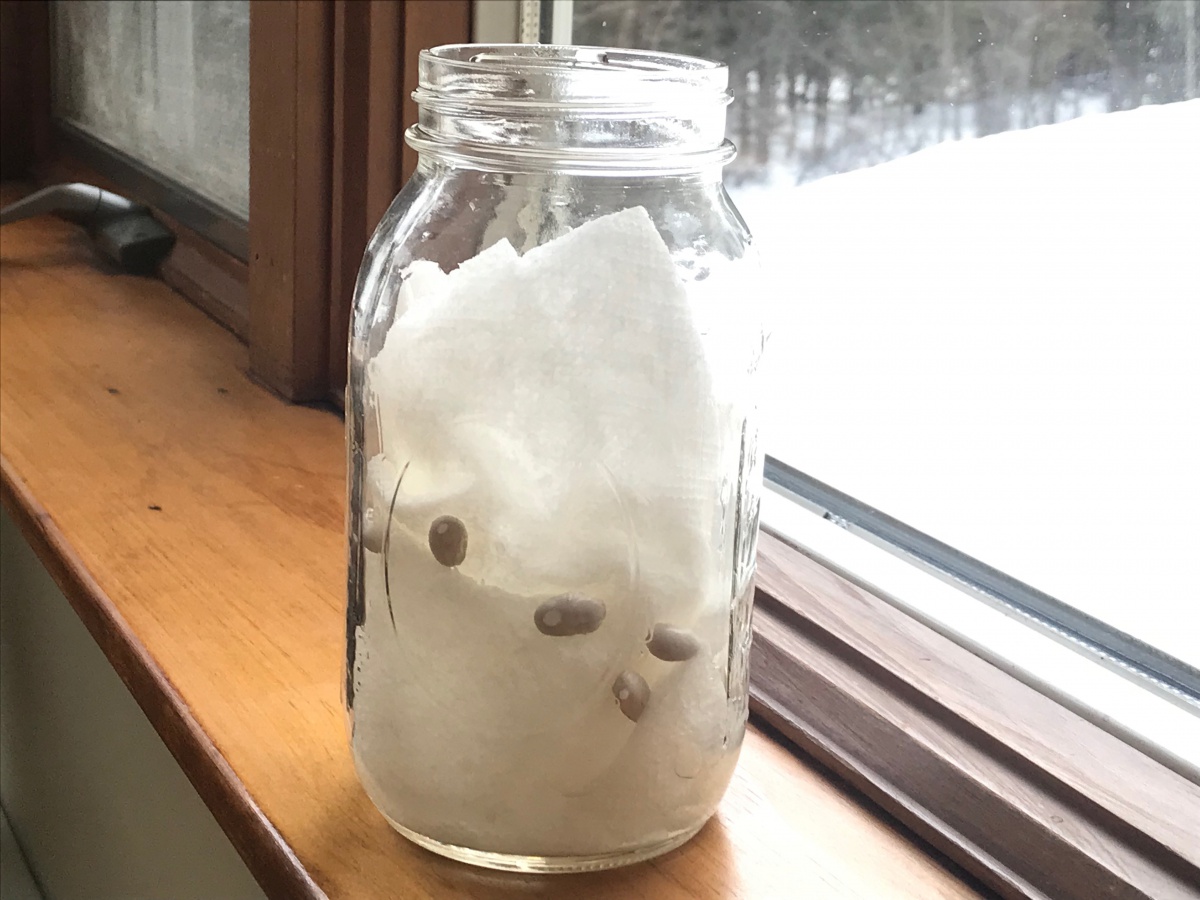Plant biologists investigate the conditions that influence plant growth and study how plants grow in different environments. They carry out these investigations both outdoors in plants’ natural habitats and indoors, in laboratories.
Today’s K-12 learners are expected to think and act as scientists to investigate real-world natural phenomena. Engaging young scientists with Grow a Bean in a Jar is one starting point for exploring the natural phenomena of plant growth. Growing beans in a glass jar requires minimal materials and provides learners with an opportunity to directly observe plant growth from seed to first leaves. This can lead to new ways of seeing and understanding the complexities of the natural environment by using a keen eye and a sense of wonder.
MATERIALS:
- Booklet with blank or unlined pages
- Pencil
- Dry lima or kidney beans (3-4)
- Glass jar
- Paper towel (strips)
- Small bowl of water to wet paper towel
- Shoe box
- Cardboard piece sized for shoe box
- Scissors
- Tape
- Optional: clipboard, colored pencils, camera, hand-lens or magnifying glass, ruler
TEACHER NOTE:
For Students in Grades 3rd-5th (with appropriate modifications)
Next Generation Science Standards (NGSS)
Disciplinary Core Idea--Life Science
Plants have different parts that help them survive and grow. (1-LS1, 4-LS1, 5-LS1)
Plants depend on water and light to grow. (2- LS2.A, 5-LS2.A)
NGSS Science Practices (SP)
SP1: Asking questions
SP2: Developing and using models
SP3: Planning and carrying out investigations
SP4: Analyzing and interpreting data
SP6: Constructing explanations
PLANT BEANS IN A JAR (Week 1):
- Using the bowl of water, wet pieces of paper towels. Paper towels should be fully saturated but not dripping wet. Line a glass jar with these wet paper towels.
- Place approximately 3-4 bean seeds (e.g., lima or kidney beans) between the jar and moist paper towels. Make sure each seed is visible.
- Record in a science notebook the date and your observation of the seeds using drawings and labels.
- Place the jar near a window for a few days.
- Observe the seeds every day. What changes (if any) do you notice?
- Only add water as needed to make sure the towels are moist.
- After 5-6 days, record your observations of the beans again using detailed drawings and labels.

CREATE A MAZE (Week 2):
- Cut a large window in one end of the shoe box.
- Cut another window in one of the pieces of cardboard. The window should be closer to an end than the middle of the piece of cardboard.
- Secure the cardboard “shelf” inside the shoe box using tape to seal all gaps.
- Place the shoe box near a sunny window.
- Add plenty of water to the glass jar to completely saturate the paper towels.
- Place the jar with the bean seeds in the shoe box on the opposite side of the window (see diagram).
- Carefully put the lid on the shoe box.
MAKE A PREDICTION:
- Predict how the plant will grow inside the box over time and explain your thinking in words, pictures and symbols in your science notebook.
- Do not open the box for 6 days with the exception to quickly check moisture of the paper towels and add water if needed.
OBSERVE GROWTH IN THE MAZE (Week 3):
- After 6 days in the maze, observe the growth of the beans inside the maze.
- Record the date and your new observations.
- How did the actual growth of the beans in the maze compare to your prediction? Why do you think your beans grew a particular way inside your maze?
- You may wish to add a second shelf with a new window and continue observations for a few more days.
- What questions emerged for you as you observed the growth of the beans in the jar and maze?
Further Exploration:
- If you want to continue this type of exploration, use one of your questions to design a new investigation to carry out.
- Learn more about the topic by reading a relevant resource or viewing a video clip about the growth of plants from seeds.
Additional Resources:
- J. Cole. 1995. The magic school bus: Plants seeds. Scholastic: NY.
- Read aloud of The magic school bus: Plants seeds. https://www.youtube.com/watch?v=_ZRLFeTHA8c
- R. Konicek-Moran. 2016. From flower to fruit. NSTA Kids Press, Arlington, VA. https://my.nsta.org/resource/105038 [e-version and hard copies available]
Acknowledgement:
Activity was adapted from NSTA’s Daily Do “How Will Plants Grow”.